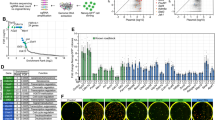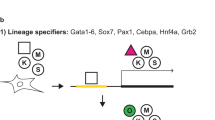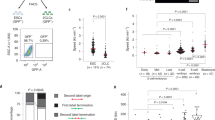Abstract
The mechanisms involved in the reprogramming of differentiated cells into induced pluripotent stem (iPS) cells by the three transcription factors Oct4 (also known as Pou5f1), Klf4 and Sox2 remain poorly understood1. The Ink4/Arf locus comprises the Cdkn2a–Cdkn2b genes encoding three potent tumour suppressors, namely p16Ink4a, p19Arf and p15Ink4b, which are basally expressed in differentiated cells and upregulated by aberrant mitogenic signals2,3,4. Here we show that the locus is completely silenced in iPS cells, as well as in embryonic stem (ES) cells, acquiring the epigenetic marks of a bivalent chromatin domain, and retaining the ability to be reactivated after differentiation. Cell culture conditions during reprogramming enhance the expression of the Ink4/Arf locus, further highlighting the importance of silencing the locus to allow proliferation and reprogramming. Indeed, the three factors together repress the Ink4/Arf locus soon after their expression and concomitant with the appearance of the first molecular markers of ‘stemness’. This downregulation also occurs in cells carrying the oncoprotein large-T, which functionally inactivates the pathways regulated by the Ink4/Arf locus, thus indicating that the silencing of the locus is intrinsic to reprogramming and not the result of a selective process. Genetic inhibition of the Ink4/Arf locus has a profound positive effect on the efficiency of iPS cell generation, increasing both the kinetics of reprogramming and the number of emerging iPS cell colonies. In murine cells, Arf, rather than Ink4a, is the main barrier to reprogramming by activation of p53 (encoded by Trp53) and p21 (encoded by Cdkn1a); whereas, in human fibroblasts, INK4a is more important than ARF. Furthermore, organismal ageing upregulates the Ink4/Arf locus2,5 and, accordingly, reprogramming is less efficient in cells from old organisms, but this defect can be rescued by inhibiting the locus with a short hairpin RNA. All together, we conclude that the silencing of Ink4/Arf locus is rate-limiting for reprogramming, and its transient inhibition may significantly improve the generation of iPS cells.
This is a preview of subscription content, access via your institution
Access options
Subscribe to this journal
Receive 51 print issues and online access
$199.00 per year
only $3.90 per issue
Buy this article
- Purchase on SpringerLink
- Instant access to full article PDF
Prices may be subject to local taxes which are calculated during checkout




Similar content being viewed by others
References
Takahashi, K. & Yamanaka, S. Induction of pluripotent stem cells from mouse embryonic and adult fibroblast cultures by defined factors. Cell 126, 663–676 (2006)
Collado, M., Blasco, M. A. & Serrano, M. Cellular senescence in cancer and aging. Cell 130, 223–233 (2007)
Serrano, M., Lin, A. W., McCurrach, M. E., Beach, D. & Lowe, S. W. Oncogenic ras provokes premature cell senescence associated with accumulation of p53 and p16INK4a. Cell 88, 593–602 (1997)
Sharpless, N. E. INK4a/ARF: a multifunctional tumor suppressor locus. Mutat. Res. 576, 22–38 (2005)
Krishnamurthy, J. et al. Ink4a/Arf expression is a biomarker of aging. J. Clin. Invest. 114, 1299–1307 (2004)
Bernstein, B. E. et al. A bivalent chromatin structure marks key developmental genes in embryonic stem cells. Cell 125, 315–326 (2006)
Azuara, V. et al. Chromatin signatures of pluripotent cell lines. Nature Cell Biol. 8, 532–538 (2006)
Mikkelsen, T. S. et al. Genome-wide maps of chromatin state in pluripotent and lineage-committed cells. Nature 448, 553–560 (2007)
Ohm, J. E. et al. A stem cell-like chromatin pattern may predispose tumor suppressor genes to DNA hypermethylation and heritable silencing. Nature Genet. 39, 237–242 (2007)
Savatier, P., Lapillonne, H., van Grunsven, L. A., Rudkin, B. B. & Samarut, J. Withdrawal of differentiation inhibitory activity/leukemia inhibitory factor up-regulates D-type cyclins and cyclin-dependent kinase inhibitors in mouse embryonic stem cells. Oncogene 12, 309–322 (1996)
Sharpless, N. E. Ink4a/Arf links senescence and aging. Exp. Gerontol. 39, 1751–1759 (2004)
Hara, E. et al. Regulation of p16 CDKN2 expression and its implications for cell immortalization and senescence. Mol. Cell. Biol. 16, 859–867 (1996)
Sherr, C. J. Divorcing ARF and p53: an unsettled case. Nature Rev. Cancer 6, 663–673 (2006)
Zhao, Y. et al. Two supporting factors greatly improve the efficiency of human iPSC generation. Cell Stem Cell 3, 475–479 (2008)
Sherr, C. J. & Roberts, J. M. CDK inhibitors: positive and negative regulators of G1-phase progression. Genes Dev. 13, 1501–1512 (1999)
Cherry, S. R., Biniszkiewicz, D., van Parijs, L., Baltimore, D. & Jaenisch, R. Retroviral expression in embryonic stem cells and hematopoietic stem cells. Mol. Cell. Biol. 20, 7419–7426 (2000)
Brambrink, T. et al. Sequential expression of pluripotency markers during direct reprogramming of mouse somatic cells. Cell Stem Cell 2, 151–159 (2008)
Stadtfeld, M., Maherali, N., Breault, D. T. & Hochedlinger, K. Defining molecular cornerstones during fibroblast to iPS cell reprogramming in mouse. Cell Stem Cell 2, 230–240 (2008)
Wei, W., Hemmer, R. M. & Sedivy, J. M. Role of p14ARF in replicative and induced senescence of human fibroblasts. Mol. Cell. Biol. 21, 6748–6757 (2001)
Evan, G. I. & d’Adda di Fagagna, F. Cellular senescence: hot or what? Curr. Opin. Genet. Dev. 19, 25–31 (2009)
Wong, D. J. et al. Module map of stem cell genes guides creation of epithelial cancer stem cells. Cell Stem Cell 2, 333–344 (2008)
Ben-Porath, I. et al. An embryonic stem cell-like gene expression signature in poorly differentiated aggressive human tumors. Nature Genet. 40, 499–507 (2008)
Blelloch, R., Venere, M., Yen, J. & Ramalho-Santos, M. Generation of induced pluripotent stem cells in the absence of drug selection. Cell Stem Cell 1, 245–247 (2007)
Takahashi, K. et al. Induction of pluripotent stem cells from adult human fibroblasts by defined factors. Cell 131, 861–872 (2007)
Park, I. H. et al. Reprogramming of human somatic cells to pluripotency with defined factors. Nature 451, 141–146 (2008)
Palmero, I. & Serrano, M. Induction of senescence by oncogenic Ras. Methods Enzymol. 333, 247–256 (2001)
Munoz, P., Blanco, R., Flores, J. M. & Blasco, M. A. XPF nuclease-dependent telomere loss and increased DNA damage in mice overexpressing TRF2 result in premature aging and cancer. Nature Genet. 37, 1063–1071 (2005)
Li, H., Vogel, H., Holcomb, V. B., Gu, Y. & Hasty, P. Deletion of Ku70, Ku80, or both causes early aging without substantially increased cancer. Mol. Cell. Biol. 27, 8205–8214 (2007)
Dickins, R. A. et al. Probing tumor phenotypes using stable and regulated synthetic microRNA precursors. Nature Genet. 37, 1289–1295 (2005)
Voorhoeve, P. M. & Agami, R. The tumor-suppressive functions of the human INK4A locus. Cancer Cell 4, 311–319 (2003)
Yuan, J. S., Reed, A., Chen, F. & Stewart, C. N. Statistical analysis of real-time PCR data. BMC Bioinformatics 7, 85 (2006)
Acknowledgements
We thank S. Lowe and R. Agami for reagents. We are grateful to M. Muñoz, O. Dominguez, D. Megias and H. Schonthaler. H.L. is the recipient of a ‘Juan de la Cierva’ contract from the Spanish Ministry of Science (MICINN). M.Co. is the recipient of a ‘Ramon y Cajal’ contract (MICINN). Work in the laboratory of M.S. is funded by the CNIO and by grants from the MICINN (SAF and CONSOLIDER), the Regional Government of Madrid, the European Union, the European Research Council (ERC), and the ‘Marcelino Botin’ Foundation.
Author Contributions H.L. performed most of the experimental work. M.Co. and A.V. made critical experimental contributions. K.S., S.O. and M.Ca. contributed experimentally. H.L., M.Co., M.A.B. and M.S. designed the experimental plan, analysed and interpreted the data. M.S. directed the project and wrote the paper.
Author information
Authors and Affiliations
Corresponding author
Supplementary information
Supplementary Information
This file contains Supplementary Table S1 and Supplementary Figures S1-S15 with Legends. (PDF 1879 kb)
Rights and permissions
About this article
Cite this article
Li, H., Collado, M., Villasante, A. et al. The Ink4/Arf locus is a barrier for iPS cell reprogramming. Nature 460, 1136–1139 (2009). https://doi.org/10.1038/nature08290
Received:
Accepted:
Published:
Issue Date:
DOI: https://doi.org/10.1038/nature08290



